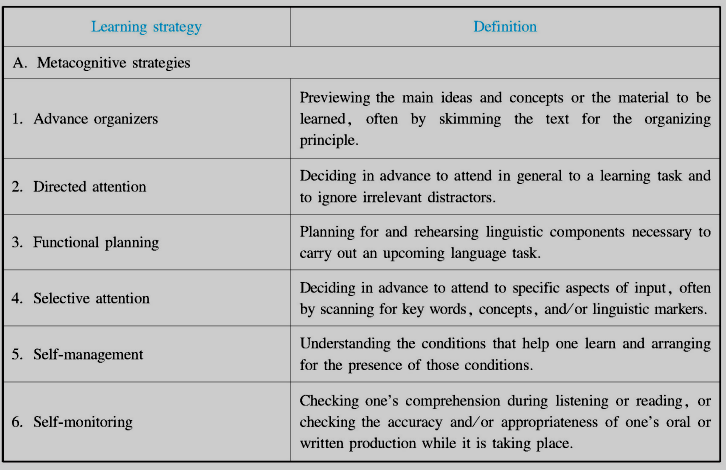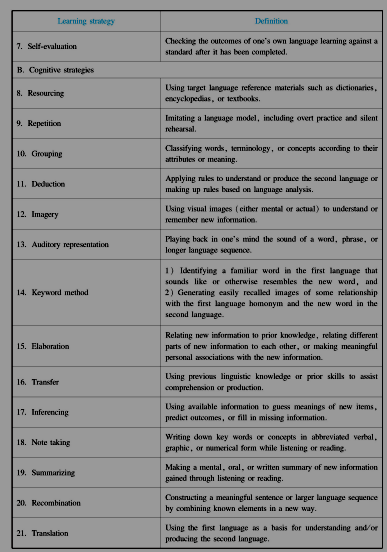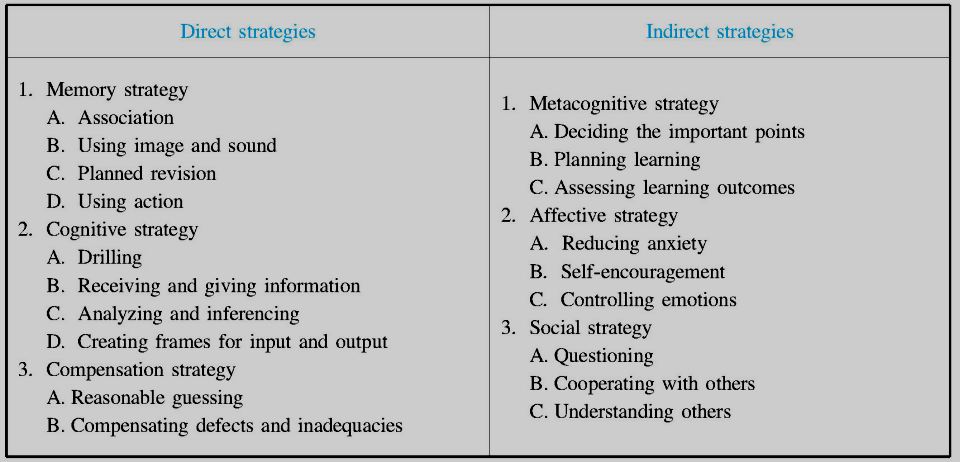Section 1 Classification of Learning Strategies
 I.Thinking
I.Thinking
【Case Reflection】
The school is holding “The Week for Learning Strategies”, promoting the effective use of learning strategies among students in all subjects. The principal has invited Ms. Zhao from the English section to give a lecture on English learning strategies, talking about what English strategies are and how they can be classified, etc.
How do you think she should organize the content of the lecture?
 II.Definition of Learning Strategy
II.Definition of Learning Strategy
The concept of strategy, which was originally borrowed from the military and adapted for state administration, has been widely used in both the East and the West for a very long time. Today, however, the concept has been far extended and employed in more fields, bringing increasing benefits to mankind. What is strategy in the contemporary world?
For a number of reasons it is not easy to give a definition of strategy which everyone agrees upon. First, strategy is not a single method, but a system of methods instead. In this system, there are a number of methods that can be used to solve certain problems, which, however, cannot be solved by any single method. That is to say, only when the whole system of methods, that is, the strategy, is put to use can we see the effectiveness. Second, strategy is not a macro-system of methods, namely, a methodology, but a micro-system of methods in response to solutions to specific problems. As we know, methodology is the reflection of our philosophical outlook on the world and guidance to think over and solve problems, but it does not address any specific problem directly. Strategy, however, is more specific. In short, strategy is a micro-system of methods rather than a single method or the simple addition of methods.
Three important characteristics of strategy can be generated by such a definition. First of all, the employment of strategies can be conscious or unconscious. For example, we may be conscious of the use of a strategy when we are using it to solve a specific problem, or we may be totally unaware of it at all. Of course it is likely that such use of strategy may be realized when we reflect afterwards, but it is also possible that we are still unaware of it, with or without reflection. Therefore, the application of a strategy cannot be judged by the user's awareness, though some scholars insist that strategy should be consciously employed. Second, despite the fact that the employment of strategy is behavioural, strategy itself is mental rather than behavioural in nature. It is a micro-system of methods, a mental resource and a mental construct whose existence does not rely on whether it is ever employed or not. Although people's ideas differ on this issue as well, the third characteristic of strategy wins overwhelming agreement, i.e., strategy itself is neutral. That is to say, there is no good or bad strategy, and what determines the value of a strategy is whether it can be appropriately employed in problem-solving situations or not. Therefore, the employment of a strategy is more important than the strategy itself.
Learning strategy, as the name suggests, is a strategy for learning, i.e., the micro-system of methods which has a direct or indirect impact on learning from the perspective of cognition, metacognition, affect, and social interaction. Learning strategies have a number of features. First, learning strategies take place in tandem with learning activities;second, the employment of learning strategies is a dynamic executive process;third, learning strategies can be implicit or explicit, and be of different levels. For example, in learning English, the learning strategies may be categorized into cognitive strategies, metacognitive strategies, affective strategies, and social strategies.
Cognitive strategy is the system of methods learners employ when they perceive, process, comprehend, memorize and retrieve information. Metacognition is the cognition of our own cognition, or, the process during which the learner monitors and controls his or her own thinking. Metacognitive strategy, therefore, includes methods by which learners monitor and control their own cognition. Affective strategy is the system of methods learners use to control and regulate their motivation, emotion and attitude, while social strategy involves methods that help learners to use English in social interactions and coordinate the relationships between themselves and others so that communication can be smoother.
 III.Classification of Learning Strategy
III.Classification of Learning Strategy
With the development of research on learning strategy, it has become increasingly important to systematically classify learning strategies. Research in this field suggests three major classifications, and four types of strategies are involved in all the three classifications, i.e. cognitive strategy, metacognitive strategy, affective strategy, and social strategy.
(I) An introduction to the classifications of learning strategies
All classifications are made according to certain criteria. Without explicit criteria, the “classifications” would be at best listings rather than standard categorizations.
One of the early systematic classifications of language learning strategies was made by O'Malley and Chamot. They primarily divided learning strategies into cognitive strategies and social strategies, namely, strategies related to learners' cognition and their social interaction. They divided cognitive strategies into metacognitive strategies and cognitive strategies, which respectively work with the learners' thinking and their behaviour. This classification of learning strategies consists of metacognitive strategies(7 items), cognitive strategies(14 items), and social strategies(2 items). Table 12-1 provides further definition.
Table 12-1 Definitions of learning strategies in O'Malley and Chamot's classification



(From Cheng & Zheng, 2002: 26-28)
Please think:
Have you employed these strategies in your English learning?Were they effective?
As seen above, there are explicit criteria in O'Malley and Chamot's classification of learning strategies, but the three categories are not well balanced in terms of item numbers. Metacognitive strategies and cognitive strategies constitute the vast majority, while there are only two social strategies. Equally, it seems possible that some specific strategies under each category, the cognitive strategies in particular, could be further subdivided. Despite these inadequacies, this classification has offered significant insights and references for further research on learning strategies.
The second classification, which has made some progress on the issue of subdivision, was proposed by Oxford. First, she divides language learning strategies into two main classes, direct and indirect, which are further divided into memory strategies, cognitive strategies and compensation strategies;metacognitive strategies, affective strategies and social strategies. These six categories were then divided into 19 subcategories, as is shown in Table 12-2.
Table 12-2 Oxford's classification of learning strategies

(From Cheng & Zheng, 2002: 29)
Please discuss:
What are the similarities and differences between the two classifications shown in Table 12-1 and Table 12-2?
Under the 19 subcategories, Oxford lists over 60 specific strategies, making a complete “strategy repertoire”. A language learning strategy scale SILL(Strategy Inventory for Language Learning)was then designed on the basis of this “repertoire”, and has since then been widely used in teaching and research.
According to Oxford, cognitive strategies can be subdivided into further categories such as memory strategies and compensation strategies, and there is a new category of learning strategies-affective strategies, which is a step-up on O'Malley and Chamot's classification, and also an advancement in our understanding of learning strategy, although there are some overlapping items in the 60 plus strategies. Arguably, the distinction between direct and indirect strategies is obscure and hard to define.
The most prominent feature of a further classification(Cohen's)is the division between language learning strategy and language use strategy. Language learning strategies include determining materials needed for learning, distinguishing materials for different purposes, classifying materials, interacting with materials, memorizing materials, etc. Language use strategies include retrieval strategies, rehearsal strategies, cover strategies and communication strategies. Such division between language learning strategy and language use strategy is very insightful, but language learning strategy is limited to materials, neglecting the complexity of language learning. A further deficiency is the lack of coherence between the subcategories under language learning strategy and those under language use strategy, due to different criteria of classification.
(II) Major categories of learning strategy
Most classifications of learning strategy include cognitive strategy, metacognitive strategy, affective strategy and social strategy.
1.Cognitive Strategy
Cognitive strategy is the system of methods we employ when we perceive, process, comprehend, memorize and retrieve information. As we know, the human brain processes information in accordance with certain cognitive rules, which also differ in the four different stages of information processing: perception, processing, memorization, and retrieval. The efficiency of this whole process can be enhanced with the aid of cognitive strategies. Learning English also involves information processing from the perspective of cognitive sciences. Cognitive strategy therefore, is closely related to many aspects of English learning, especially to the acquisition of language knowledge and language skills.
The acquisition of language knowledge mainly involves pronunciation, vocabulary, and grammar. In terms of learning pronunciation, learners need to grasp the phonetic features of English language, compare and contrast the similarities and differences between English and Chinese pronunciation, and memorize phonetic rules. All the above require the support of cognitive strategies. When studying vocabulary, learners first need to perceive the new words, and then process their pronunciation, spelling and grammatical features, and then try to memorize them and finally be able to quickly retrieve and use them whenever needed. It is almost impossible to complete these tasks without the use of cognitive strategies. Similarly, the learning of grammar requires the use of cognitive strategies. Learners are not only required to remember the grammatical rules, but also be able to produce correct utterances with them. Understanding the features of English grammar, which is an important part of the uniqueness of English language, also requires the employment of cognitive strategies.
2.Metacognitive strategy
Metacognitive strategy is regarded as a system of methods by which learners monitor and control their own cognition. Metacognition, which is defined as the cognition of cognition, is an advanced cognitive capacity. Metacognitive strategies can help monitor and simultaneously control one's cognition by monitoring the rate, nature, and obstacles to our cognition. For example, when we read an English essay, metacognitive strategies can help us to evaluate the speed and quality of reading, and choose appropriate cognitive strategies to enhance the understanding. After a day's study, we need to reflect on what we have achieved and what still needs to be improved. The effectiveness of such reflection is mostly dependent on the employment of metacognitive strategies. If we can evaluate our achievements and problems following a rational thinking framework, then we are more likely to benefit from the outcome of our reflection. Otherwise, our reflection might be inconclusive and poorly informed, which would have little effect on later study.
Controlling cognition is another aspect of metacognitive strategies. The most typical example is making learning plans, which most students do. Even if all these plans were religiously implemented, the outcomes would also vary, due to the fact that the quality of the planning, i.e. the use of metacognitive strategies, differs. If the metacognitive strategies are appropriately employed, the learning plans will suit us better and then facilitate our learning;if not, the plans will not be feasible or useful enough to help us with the learning. In short, metacognitive strategies play an important role in our English learning.
3.Affective strategy
Affective strategy is regarded as a system of methods by which learners control and regulate their motivation, emotion and attitude. There is a close connection between motivation and learning efficiency. Learners with weak motivation or those who cannot effectively motivate themselves to advance their learning are more likely to have problems with the employment of affective strategies which enhance the awareness of learning interest and strengthen motivation. As not all interest is instinctive and spontaneous, it takes strategies to develop interest as well. Affective strategies can also help us to encourage ourselves when tackling difficulties;to regulate our negative emotions and to build a positive attitude to learning cooperatively.
4.Social strategy
Social strategy is regarded as a system of methods by which learners use English to coordinate the relationships between themselves and others in social interactions and so that communication can be smoother. Social strategies can help us to identify and utilize opportunities for language output in real language use contexts, and to raise our awareness of learning English through authentic social interactions and classroom communicative activities. When we interact with others while learning or using English, social strategies help us to build and maintain good relationships, and to learn differences in communication, thereby helping us to compensate for inadequacies in our own language proficiency.
